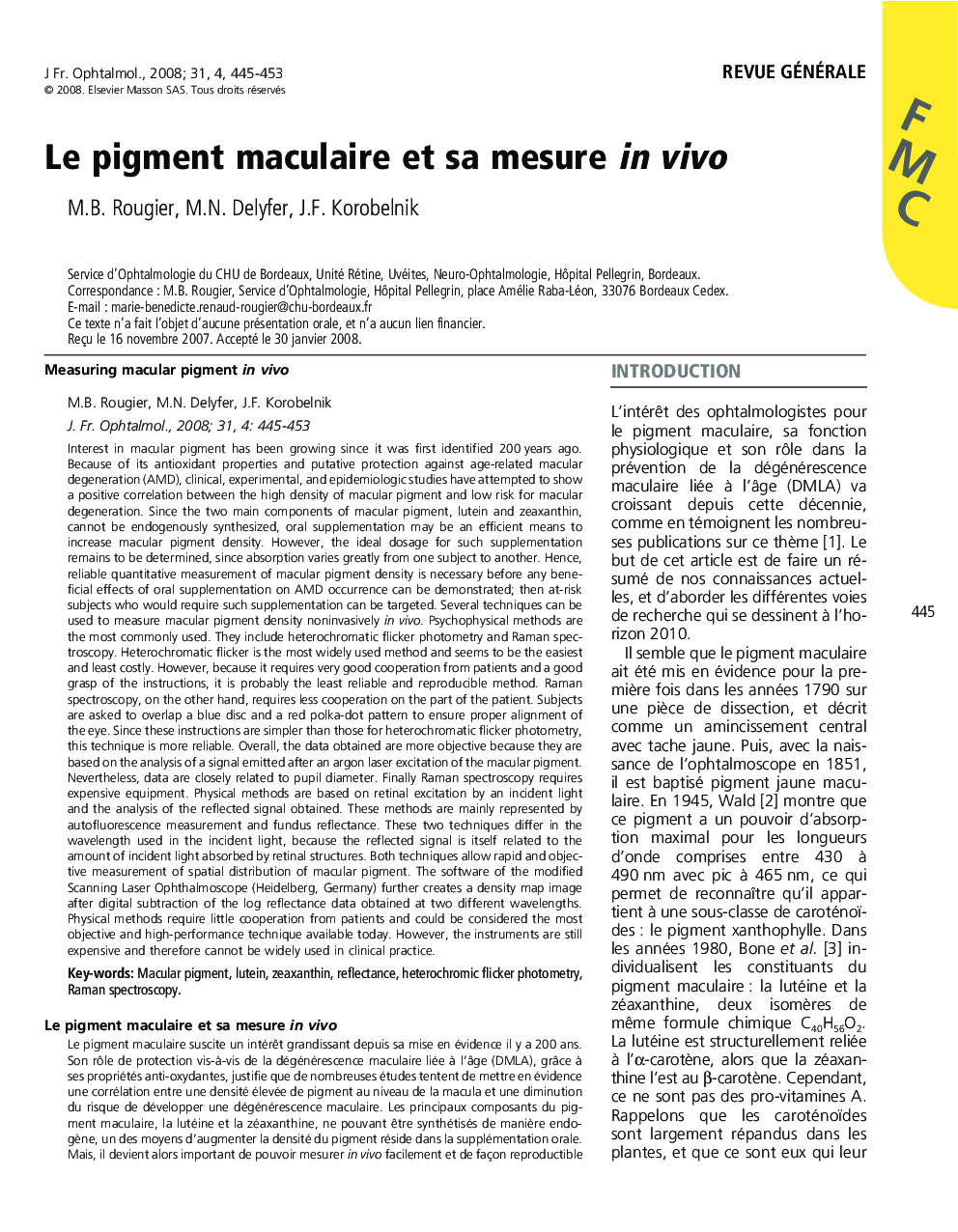| کد مقاله | کد نشریه | سال انتشار | مقاله انگلیسی | نسخه تمام متن |
|---|---|---|---|---|
| 4025274 | 1262349 | 2008 | 9 صفحه PDF | دانلود رایگان |

Measuring macular pigment in vivoM.B. Rougier, M.N. Delyfer, J.F. KorobelnikInterest in macular pigment has been growing since it was first identified 200 years ago. Because of its antioxidant properties and putative protection against age-related macular degeneration (AMD), clinical, experimental, and epidemiologic studies have attempted to show a positive correlation between the high density of macular pigment and low risk for macular degeneration. Since the two main components of macular pigment, lutein and zeaxanthin, cannot be endogenously synthesized, oral supplementation may be an efficient means to increase macular pigment density. However, the ideal dosage for such supplementation remains to be determined, since absorption varies greatly from one subject to another. Hence, reliable quantitative measurement of macular pigment density is necessary before any beneficial effects of oral supplementation on AMD occurrence can be demonstrated; then at-risk subjects who would require such supplementation can be targeted. Several techniques can be used to measure macular pigment density noninvasively in vivo. Psychophysical methods are the most commonly used. They include heterochromatic flicker photometry and Raman spectroscopy. Heterochromatic flicker is the most widely used method and seems to be the easiest and least costly. However, because it requires very good cooperation from patients and a good grasp of the instructions, it is probably the least reliable and reproducible method. Raman spectroscopy, on the other hand, requires less cooperation on the part of the patient. Subjects are asked to overlap a blue disc and a red polka-dot pattern to ensure proper alignment of the eye. Since these instructions are simpler than those for heterochromatic flicker photometry, this technique is more reliable. Overall, the data obtained are more objective because they are based on the analysis of a signal emitted after an argon laser excitation of the macular pigment. Nevertheless, data are closely related to pupil diameter. Finally Raman spectroscopy requires expensive equipment. Physical methods are based on retinal excitation by an incident light and the analysis of the reflected signal obtained. These methods are mainly represented by autofluorescence measurement and fundus reflectance. These two techniques differ in the wavelength used in the incident light, because the reflected signal is itself related to the amount of incident light absorbed by retinal structures. Both techniques allow rapid and objective measurement of spatial distribution of macular pigment. The software of the modified Scanning Laser Ophthalmoscope (Heidelberg, Germany) further creates a density map image after digital subtraction of the log reflectance data obtained at two different wavelengths. Physical methods require little cooperation from patients and could be considered the most objective and high-performance technique available today. However, the instruments are still expensive and therefore cannot be widely used in clinical practice.
Le pigment maculaire et sa mesure in vivoLe pigment maculaire suscite un intérêt grandissant depuis sa mise en évidence il y a 200 ans. Son rôle de protection vis-à-vis de la dégénérescence maculaire liée à l’âge (DMLA), grâce à ses propriétés anti-oxydantes, justifie que de nombreuses études tentent de mettre en évidence une corrélation entre une densité élevée de pigment au niveau de la macula et une diminution du risque de développer une dégénérescence maculaire. Les principaux composants du pigment maculaire, la lutéine et la zéaxanthine, ne pouvant être synthétisés de manière endogène, un des moyens d’augmenter la densité du pigment réside dans la supplémentation orale. Mais, il devient alors important de pouvoir mesurer in vivo facilement et de façon reproductible la densité du pigment maculaire, afin de dépister les sujets ayant un taux de pigment bas, d’évaluer les effets d’une telle supplémentation, et de cibler les sujets qui pourraient en bénéficier. Cette mise au point tente de reprendre l’état de nos connaissances actuelles sur le pigment maculaire, et de passer en revue les différentes techniques de mesure chez l’homme.
Journal: Journal Français d'Ophtalmologie - Volume 31, Issue 4, April 2008, Pages 445–453